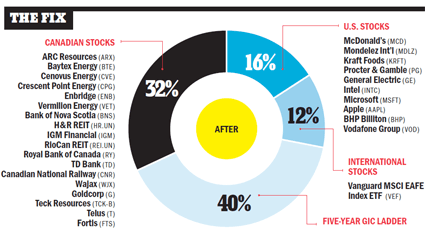Taking stock of their future
Brenda and Kent Biggar parted ways with their adviser.
Advertisement
Brenda and Kent Biggar parted ways with their adviser.
Brenda and Kent Biggar are newly minted do-it-yourself investors who recently opened accounts with a discount brokerage. “We were just trying to get out of mutual funds and into individual stocks and ETFs,” says Kent. The Biggars, who are in their early fifties and live in Tyne Valley, P.E.I., plan to build a portfolio that’s 60% stocks and 40% fixed income. They’ve already bought several blue-chip Canadian and U.S. dividend payers, plus some bonds and GICs rate but about 30% of their money is still in mutual funds (none of them DSC). “If we sold all that portion, where do you suggest putting that money?” Brenda asks.

“This portfolio must be easy to manage if they are going to be successful on their own,” says David Predovich of TD Wealth Private Investment Advice in Toronto, who reviewed the couple’s situation. “It’s built on a foundation of strong Canadian companies, so let’s not change more than necessary.” He recommends keeping about a third of the portfolio in Canadian dividend payers. “Their focus should be on stable, growing companies that are expected to continue increasing their dividends,” he says. The Biggars should keep these Canadian equities in their non-registered accounts, where they will be eligible for the dividend tax credit.
Predovich also suggests about one-sixth of their holdings should be in blue-chip U.S. companies. “It’s difficult to find good companies in every sector in Canada.” His picks include consumer, technology and health-care stocks lacking in the domestic market. He also recommends an ETF of international stocks. Lowest cost is the Vanguard MSCI EAFE Index ETF (VEF), a MoneySense ETF All-Star (our pick, not his.)
For fixed income, Predovich recommends avoiding bonds and going with a five-year GIC ladder. “In a low interest-rate environment, there is absolutely nothing wrong with this strategy,” he says, pointing out that bonds will lose value if rates rise.
Finally, the Biggars should set some rules about when to sell. “Keep an eye out for companies whose earnings estimates have been slashed more than their peers,” Predovich suggests.
Do you want a portfolio makeover from MoneySense? If so, send an email describing your situation to [email protected],
Share this article Share on Facebook Share on Twitter Share on Linkedin Share on Reddit Share on Email